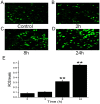Novel mechanisms for crotonaldehyde-induced lung edema
- PMID: 29137360
- PMCID: PMC5663532
- DOI: 10.18632/oncotarget.17840
Novel mechanisms for crotonaldehyde-induced lung edema
Abstract
Background: Crotonaldehyde is a highly noxious α,β-unsaturated aldehyde in cigarette smoke that causes edematous acute lung injury.
Objective: To understand how crotonaldehyde impairs lung function, we examined its effects on human epithelial sodium channels (ENaC), which are major contributors to alveolar fluid clearance.
Methods: We studied alveolar fluid clearance in C57 mice and ENaC activity was examined in H441 cells. Expression of α- and γ-ENaC was measured at protein and mRNA levels by western blot and real-time PCR, respectively. Intracellular ROS levels were detected by the dichlorofluorescein assay. Heterologous αβγ-ENaC activity was observed in an oocyte model.
Results: Our results showed that crotonaldehyde reduced transalveolar fluid clearance in mice. Furthermore, ENaC activity in H441 cells was inhibited by crotonaldehyde dose-dependently. Expression of α- and γ-subunits of ENaC was decreased at the protein and mRNA level in H441 cells exposed to crotonaldehyde, which was probably mediated by the increase in phosphorylated extracellular signal-regulated protein kinases 1 and 2. ROS levels increased time-dependently in cells exposed to crotonaldehyde. Heterologous αβγ-ENaC activity was rapidly eliminated by crotonaldehyde.
Conclusion: Our findings suggest that crotonaldehyde causes edematous acute lung injury by eliminating ENaC activity at least partly via facilitating the phosphorylation of extracellular signal-regulated protein kinases 1 and 2 signal molecules. Long-term exposure may decrease the expression of ENaC subunits and damage the cell membrane integrity, as well as increase the levels of cellular ROS products.
Keywords: alveolar fluid clearance; crotonaldehyde; epithelial sodium channels; lung injury; reactive oxygen species.
Conflict of interest statement
CONFLICTS OF INTEREST The authors declare that they have no conflicts of interest.
Figures









Similar articles
-
Formaldehyde impairs transepithelial sodium transport.Sci Rep. 2016 Oct 20;6:35857. doi: 10.1038/srep35857. Sci Rep. 2016. PMID: 27762337 Free PMC article.
-
Luteolin attenuates lipopolysaccharide-induced acute lung injury/acute respiratory distress syndrome by activating alveolar epithelial sodium channels via cGMP/PI3K pathway.J Ethnopharmacol. 2022 Jan 10;282:114654. doi: 10.1016/j.jep.2021.114654. Epub 2021 Sep 16. J Ethnopharmacol. 2022. PMID: 34537283
-
Conditioned Medium of Bone Marrow Mesenchymal Stem Cells Involved in Acute Lung Injury by Regulating Epithelial Sodium Channels via miR-34c.Front Bioeng Biotechnol. 2021 Jul 1;9:640116. doi: 10.3389/fbioe.2021.640116. eCollection 2021. Front Bioeng Biotechnol. 2021. PMID: 34368091 Free PMC article.
-
K+ channels regulate ENaC expression via changes in promoter activity and control fluid clearance in alveolar epithelial cells.Biochim Biophys Acta. 2012 Jul;1818(7):1682-90. doi: 10.1016/j.bbamem.2012.02.025. Biochim Biophys Acta. 2012. PMID: 22406554
-
Importance of ENaC-mediated sodium transport in alveolar fluid clearance using genetically-engineered mice.Cell Physiol Biochem. 2010;25(1):63-70. doi: 10.1159/000272051. Epub 2009 Dec 22. Cell Physiol Biochem. 2010. PMID: 20054145 Review.
Cited by
-
Presynaptic Homeostasis Opposes Disease Progression in Mouse Models of ALS-Like Degeneration: Evidence for Homeostatic Neuroprotection.Neuron. 2020 Jul 8;107(1):95-111.e6. doi: 10.1016/j.neuron.2020.04.009. Epub 2020 May 6. Neuron. 2020. PMID: 32380032 Free PMC article.
-
Ferulic acid ameliorates lipopolysaccharide-induced tracheal injury via cGMP/PKGII signaling pathway.Respir Res. 2021 Dec 4;22(1):308. doi: 10.1186/s12931-021-01897-4. Respir Res. 2021. PMID: 34863181 Free PMC article.
-
Upregulation of the WNK4 Signaling Pathway Inhibits Epithelial Sodium Channels of Mouse Tracheal Epithelial Cells After Influenza A Infection.Front Pharmacol. 2019 Jan 22;10:12. doi: 10.3389/fphar.2019.00012. eCollection 2019. Front Pharmacol. 2019. PMID: 30723408 Free PMC article.
-
Bone marrow mesenchymal stem cell-conditioned medium facilitates fluid resolution via miR-214-activating epithelial sodium channels.MedComm (2020). 2020 Nov 12;1(3):376-385. doi: 10.1002/mco2.40. eCollection 2020 Dec. MedComm (2020). 2020. PMID: 34766129 Free PMC article.
-
Microbiome alterations from volatile organic compounds (VOC) exposures among workers in salons primarily serving women of color.Environ Res. 2022 Nov;214(Pt 4):114125. doi: 10.1016/j.envres.2022.114125. Epub 2022 Aug 18. Environ Res. 2022. PMID: 35987373 Free PMC article.
References
-
- Kellenberger S, Schild L. International union of basic and clinical pharmacology. XCI. Structure, function, and pharmacology of acid-sensing ion channels and the epithelial Na+ channel. Pharmacol Rev. 2015;67:1–35. - PubMed
Grants and funding
LinkOut - more resources
Full Text Sources
Other Literature Sources

